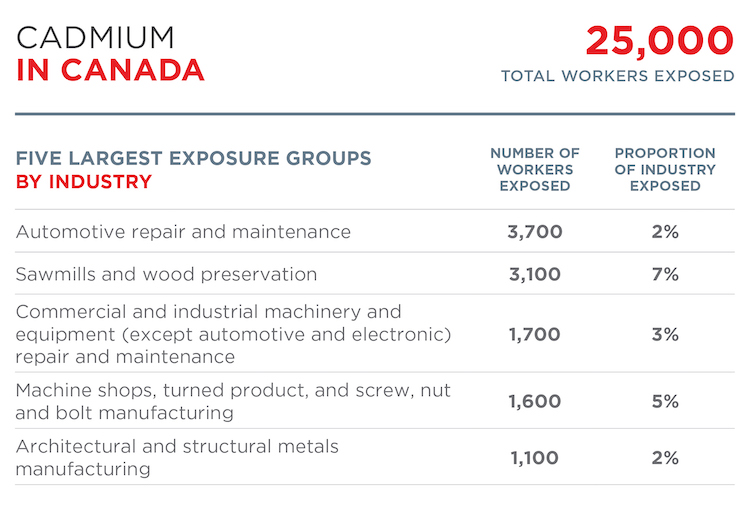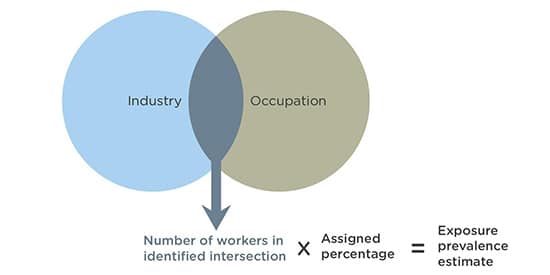Cadmium Occupational Exposures
Cadmium Occupational Exposures
Overview
Inhalation is the main route of exposure to cadmium in occupational settings.[1] CAREX Canada estimates that approximately 25,000 Canadians are exposed to cadmium at work, with most of these exposures occurring in the moderate exposure category.
READ MORE...
In Canada, the industry with the largest number of workers occupationally exposed to cadmium is automotive repair and maintenance, followed by sawmill and wood preservation (where workers are exposed through sawfiling or working near sawfiling areas), and commercial and industrial machinery repair and maintenance.
When exposure is examined by occupation, the largest occupational group exposed is welders. Welders are employed in diverse industries, and this exposure can occur when welding cadmium-coated surfaces or stainless steel that contains cadmium. Other important exposed groups include automotive service technicians and machinists and machining and tooling inspectors.
Prevalence Estimate
Results show that approximately 25,000 Canadians are potentially exposed to cadmium at work; 92% of these workers are male. The largest industrial group exposed is automotive repair and maintenance, followed by sawmill and wood preservation (where workers are exposed through sawfiling or working near sawfiling areas), and commercial and industrial machinery repair and maintenance.
When exposure is examined by occupation, the largest occupational group exposed is welders (9,700 workers exposed) where exposure to cadmium or cadmium compounds can occur when welding stainless steel containing cadmium or surfaces that are cadmium coated or plated. Other important exposed groups include automotive service technicians (3,600 workers exposed) and machinists and machining and tooling inspectors (1,200 workers exposed).
The number of workers exposed to cadmium decreased by approximately 6,300 workers from 2006 to 2016 (a 20% decrease). This was driven by a decrease in the total number of workers in the sawmills and wood preservation industry.
Workers exposed to cadmium by industry in 2016

Workers exposed to cadmium by region in 2016
Click the second tab to view total number of workers exposed.
* = < 50 workers
Level of Exposure
In total, approximately 25,000 Canadians are exposed to cadmium in their workplaces. The majority of workers exposed to cadmium are in the moderate exposure category. A relatively small number of cadmium-exposed workers are at risk for high exposure.
Workers exposed to cadmium by exposure level in 2016
Level of exposure by industry
Identifying industries with either 1) workers exposed to high levels of cadmium or 2) a larger number of workers exposed to cadmium is important in guiding cancer prevention efforts to prioritize exposed groups and target resources most effectively.
The table below shows the number of workers exposed by industry group and level of exposure to cadmium. These results highlight industries with the most number of workers, as well as industries with the highest levels of exposure. For example, in the repair and maintenance industry, all of the workers fall into the low and moderate exposure categories. However, in the wood products manufacturing industry, a substantial proportion of the exposed workers (31%) are in the high exposure category. Depending on the goals of a prevention campaign, exposure reduction in the large industrial group might be a useful strategy, or reducing exposure to those at highest risk of exposure could be seen as a priority.
Workers exposed to cadmium by exposure level and industry in 2016
*Numbers may not add up due to rounding
Methods and Data
Our Occupational Approach page outlines the general approach used to calculate prevalence and exposure level estimates for workplace exposures.
Data Sources
Data used in developing the occupational estimates for cadmium were collected from several sources:
- The Canadian Workplace Exposure Database (CWED) contains over 2,700 measurements for cadmium exposure. These measurements were collected during the years 1981 to 2004 in Ontario and British Columbia workplaces.
- Canadian and US scientific peer reviewed publications that addressed cadmium exposure in Canada and the United States.
- Grey literature including technical reports from governments and international bodies.
Prevalence Estimate Method
CAREX defines exposure to cadmium as inhalation exposure at work to levels which significantly exceed ambient background levels.
To determine the number of workers potentially exposed to cadmium at work, CAREX occupational exposure experts used methods previously established in other peer-reviewed CAREX projects in Europe. A series of steps were taken to assign exposure proportions to occupations and industries at risk of exposure to cadmium.

- Occupations and industries at risk of possible exposure to cadmium were identified using any combination of data sources described above.
- The total number of workers in each identified occupation and industry intersection was obtained from Statistics Canada 2016 census data.
- A percentage of workers exposed was assigned to that occupation and industry intersection. Percentages were determined by consultation with existing evidence in the data sources, previously established methods from the Europe CAREX estimates and the expert judgement of CAREX occupational hygienists.
- The number of workers in the identified group is multiplied by the assigned percentage to calculate the prevalence estimate of workers exposed to cadmium.
Exposure Level Method
CAREX uses available workplace exposure measurements in the CWED to create exposure level categories by industry and occupation. For cadmium and its compounds, these categories are:
Category 1: Low Exposure
A group of workers (people in the same job category and industry) is put in this exposure category for one of two reasons:
- The are no valid measurements, but a hygienist identified this group as typically exposed during literature and other reviews;
- There are valid exposure measurements in the CWED and a hygienist review determined that exposure is plausible; AND EITHER:
- There are less than 10 samples available in the CWED, OR
- There are ≥10 measurements available but they do not meet the criteria for Moderate Exposure.
Category 2: Moderate Exposure
A group of workers is put in this exposure category if:
- There are at least 25 individual samples in the CWED, AND
- 20% or more samples have a value higher than 0.001 mg/m3 (which is half the current occupational exposure limit for cadmium compounds),
OR
- There are at least 10 individual samples in the CWED, AND
- 20% or more samples have a value higher than 0.002 mg/m3 (which is the current occupational exposure limit for cadmium compounds).
Category 3: High Exposure
A group of workers is put in this exposure category if both these criteria are met:
- There are at least 25 individual samples in the CWED, AND
- 20% or more samples have a value higher than 0.002 mg/m3 (which is the current occupational exposure limit for cadmium compounds).
Sources
Subscribe to our newsletters
The CAREX Canada team offers two regular newsletters: the biannual e-Bulletin summarizing information on upcoming webinars, new publications, and updates to estimates and tools; and the monthly Carcinogens in the News, a digest of media articles, government reports, and academic literature related to the carcinogens we’ve classified as important for surveillance in Canada. Sign up for one or both of these newsletters below.
CAREX Canada
School of Population and Public Health
University of British Columbia
Vancouver Campus
370A - 2206 East Mall
Vancouver, BC V6T 1Z3
CANADA
As a national organization, our work extends across borders into many Indigenous lands throughout Canada. We gratefully acknowledge that our host institution, the University of British Columbia Point Grey campus, is located on the traditional, ancestral and unceded territories of the xʷməθkʷəy̓əm (Musqueam) people.



